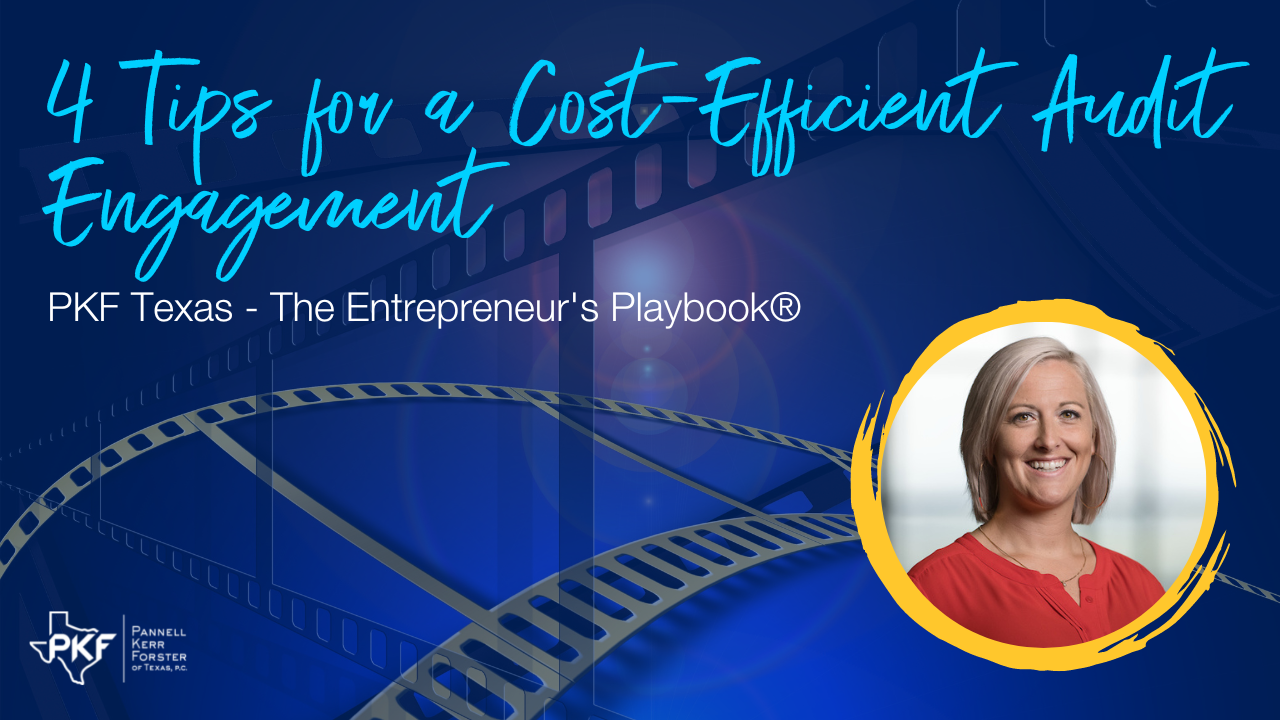4 Tips for a Cost-Efficient Audit Engagement

It’s true an audit can be costly, but for your not-for-profit, it might be a good investment that helps with your fiscal responsibilities, due diligence, and grants. So, what can your organization do to have a cost-efficient engagement? Audit Director, Nicole Riley, CPA, CFE, offers some tips to consider.
Table of contents
Jen: This is the PKF Texas – Entrepreneur’s Playbook®. I’m Jen Lemanski and I’m back once again with Nicole Riley, an Audit Director and one of the Approachable Advisors™ on our not-for-profit team here at PKF Texas. Nicole, welcome to the Playbook.
Nicole: Thanks for having me.
Jen: So, Audit Director, not-for-profits. Not-for-profits need audits?
Nicole: Yes, they do.
Why Not-for-Profits Need an Audit
Jen: Why?
Nicole: Well, there’s usually three main reasons that we see. The first is the board wants to have good governance, so they feel it’s a part of their fiscal responsibility to have an audit of the organization. Second is if they have bank debt and the bank requires it.
Jen: That makes sense.
Nicole: And then third most common is when we have a funding source that requires it. And there can be different aspects of that because if you have federal funding and you have $750,000 or more of it, you are required to have an audit, and it has to be under the Uniform Guidance rules. But then state government grants also usually have an audit requirement, some local in foundations, and then we often see more significant grants that are higher in size that want an audit report as part of the grant application process.
Jen: Okay. So just even to apply for the grant, you’ve got to have one.
Nicole: Yeah. So, they want to see that that’s part of your due diligence, part of your fiscal responsibility and just part of the regular operations of the organization.
Jen: So, I would imagine, obviously we like to get paid, there’s an added cost to doing that. So, is there a way to keep costs, and I’m going to say “manageable,” for an audit because a lot of times not-for-profits are… they could be dealing with a lot of money or they could be dealing with not much and kind of bootstrapping it.
Keeping Costs Manageable
Nicole: So, an audit has a certain amount of things that we have to do. We have to meet our standards. There are generally accepted audit standards. So, there is a certain level no matter what size organization, unfortunately, that just we have to do.
But when we build our budget for an audit, it’s based on the hours it takes, but an organization can do some things to keep our hours down. The first and foremost that I always tell clients is be prepared. So, we give our clients a list and it’s a lengthy list.
Jen: It’s pretty long I’ve seen that list.
Nicole: But if you have that list of items already uploaded and provided to us before we start fieldwork, that is automatically going to give us efficiencies in what we’re doing and enable us to get through things quicker.
The second is to be responsive. If we come back with a sample size or if we need some additional invoices, if the client can get those back to us right away or within a pretty reasonable amount of time, that just helps the audit continue to move, like not to stall out, not to waste time, not to have to double back and ask for it again. Every time we have to ask for things, it’s just additional time that it takes for us. So, that’s kind of step two.
And then the third one I see most often is if the client’s organized. And what I mean by that is a lot of times we’ll get the information, but… for example, if we’re testing inventory and we get a 30-page document and we have to search and try to find that one line that we’re looking for, it just takes time.
So, when the clients will highlight things for us, point out where it is, put a box around it, here’s what you’re looking for and explain their spreadsheets to us, those are big things that help reduce our amount of time. It reduces the back and forth and can really keep the hours in check and keep your audit fee from going up.
Reading the Report
Jen: So, beyond testing, is there anything else that you guys do as part of that audit?
Nicole: So, the other thing I like to talk about with when it comes to audits and not-for-profits, and especially with management, is to really read that whole audit report. And I know it’s long and I know it can be a lot of information, but management’s really responsible for that whole audit report.
Jen: And knowing what’s in there.
Nicole: Right. And making sure not only is it correct, but it’s complete. So that’s really important for them to read that whole thing and understand what’s in it. And I like my clients to ask me about the management letter and go through those comments, and even if we didn’t issue a management letter to ask us about things that we noticed during testing, that just wasn’t a finding.
And those are usually things that we just noticed that are best practices, good governance items that we came across. But it’s not a deficiency, it’s not required to be in writing, but things that the organization could do better at and could improve their efficiencies on their side as well.
Jen: Perfect. Well, sounds like we’ve got a lot more to talk about and related to audits and not-for-profits. We’ll get you back to talk about that soon. Sound good?
Nicole: Sounds great.
Jen: For more information about this in other topics, visit PKFTexas.com/Insights. This has been another thought leadership production brought to you by PKF Texas – The Entrepreneur’s Playbook®. Tune in next week for another chapter.

